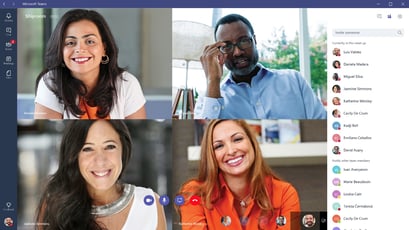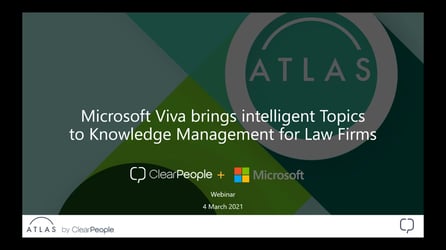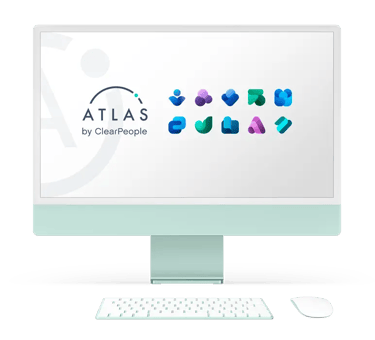The current rate of Microsoft Teams adoption is monumental. This trend has been excelling for the last few years. Statistics show staggering rises, for example between 2019 and Q2 2021 the number of Microsoft Teams users jumped from 20 million to 145 million.
The surge was initially triggered by the pandemic because of the sheer volume of people working remotely. As we are now within a new era of hybrid working (a new way of working that is likely to stay), we are seeing the upward trend of Microsoft Teams adoption continuing.
Organisations are seeing tangible benefits from using such technologies. Digital technologies within the working environment are seeing huge investments from the likes of Microsoft. They firmly believe (and are certainly not alone) that the digital workplace will play an integral part within most organisations. This had led to the development and launch of a new category of software termed the Employee Experience Platform and Microsoft call this Microsoft Viva.
Microsoft Viva is an employee experience platform that sits within Microsoft Teams. According to Satya Nadella, Microsoft’s CEO “Viva digitally re-imagines company culture, employee well-being, knowledge sharing and learning for the hybrid work world”.
Microsoft Teams has become a central hub where many people spend a significant part of their working day. When I was initially introduced to Teams, I paired it off in my mind as another digital tool just like Zoom. A place to meet people virtually. It is however now the place where I spend a significant part of my working day. I use Teams to collaborate with my work colleagues, even this blog has been uploaded onto Teams so that the colleagues within my department are able to review it. I also engage with colleagues from a number of different departments and groups about projects we’re mutually involved in, sharing information ranging from documents I’ve worked on to interesting articles I’ve found, industry trends and analysis, updates and so on.

Microsoft Teams is now an integral part of the communication and collaboration within many organisations, and this is down to these shifts in changing working patterns. As Jens Rassloff, Global Head of Strategic Relations & Investments, KPMG points out: “The world of work is evolving at speed. The workforce, workplace and workspace are all changing the nature of work, and learning is evolving with it.”
It’s not just the end user functionality that is making Teams the go to platform for collaboration either. Microsoft’s robust and compliant framework is also a major reason why organisations are choosing Teams for communication and collaboration. Microsoft Teams protects data and privacy. The ability to restrict and define data groups enables organisations to work within parameters that can meet stringent regulatory requirements such as GDPR. Restrictions don’t however get in the way of organisation access to their own data (for example customer data). They are tenants, within their own cloud. This is an important feature of cloud computing.
It’s no wonder we are seeing this paradigm shift towards digital working practices. As with any major shift however it isn’t without concerns and direct problems to address. One area for focus within this uptake of digital working practices is the employee experience. In order to operate digital working practices properly, organisations should take a holistic approach to an employee’s experience when using digital tools. This has been proven to be a serious area for concern. Overwhelm, overload, burnout and stress have been real outcomes from working remotely during the pandemic. People are working harder, taking less holidays and wasting more time than ever on irrelevant emails and not being able to find the information they need to do their jobs quickly and efficiently. This is where the Employee Experience Platform comes into play. Microsoft have coined it as an “organizing layer”. They believe that the solution to this problem is to integrate software specially designed to address the problems associated with employee well-being into the apps people use every day. This will enable organisations to alleviate some of the problems born out of employees working remotely and spending a significant proportion of time working within digital tools. Microsoft Viva addresses these concerns specifically. Satya Nadella, Microsoft CEO states:
“People operations will no longer be limited to HR but will be integrated across every aspect of the business in order to improve the overall health and resilience of the organization. Every organization will require a unified employee experience from on-boarding and collaboration to continuous learning and growth.
These can no longer be siloed functions. A world of flexible work creates new challenges. How do you keep everyone connected to your mission and sense of purpose? How do you create and sustain culture digitally? How do you onboard new talent? How do you help them learn and grow? How do you ensure they always are collaborating with the right people?
Addressing these challenges and incorporating solutions into everyday workflow tools is more critical than ever. That’s why today, we’re announcing Microsoft Viva.”
![]()
Accessed through Microsoft Teams, Microsoft Viva supports organisations and their employees alike to balance wellbeing and productivity throughout the working day. It doesn’t take a short-term viewpoint. It’s designed to support each individual employee throughout their entire career with the organisation. This employee experience platform provides the tools and the infrastructure to enable a number of well-being best practices, including support for better time management, removal of communication barriers, learning and progression, monitoring of stress.
It provides learning support within a range of areas from role specific, career progression and digital skill support. It uses AI powered technology to make experiences personalised and relevant to the employee. From the organisation’s perspective, managers can develop their teams, respond to employee needs and improve team performance. Business leaders can access stats on productivity and engagement so that they can make more informed decisions through analysis, understanding and guiding of how work happens.
Microsoft Viva is set out into 4 modules:
Viva Connections: Is a new framework that provides the infrastructure to enable an organisation to deliver its intranet within Microsoft Teams. It delivers a personalised feed of information that a specific user needs such as news, conversations and communities (such as Yammer) that are useful to them. Apps can be targeted to specific users to link to the app experience directly or it can deliver the experience inside the framework itself, for example a clock in board for workers who work shift patterns can be placed on the homepage and only show for those workers who need to clock in every day. Resources include ‘pinned’ functionality, meaning you can pin for example, a news item to the top of the feed, recently opened SharePoint sites, links from the home-site, yammer communities and top video playlists.
Viva Topics: Puts knowledge to work across an organisation. An organisation’s pool of shared information will naturally grow. What is critical however is to ensure that as the pool grows the complexity of finding and accessing the information doesn’t also grow. That aspect needs to be simplified. If the complexity of finding knowledge and information isn’t addressed then it can lead to a number of problems: wasted time searching and recreating information, knowledge drain, frustration and reduced productivity. Microsoft states Viva Topics aims to address these issues by preserving knowledge, reducing disruptions and optimising people’s time. “Microsoft Viva Topics uses artificial intelligence (AI) to empower people with knowledge and expertise in the apps they use every day and to connect, manage, and protect content across systems and teams.” Microsoft. And it doesn’t stop there. Microsoft says that soon Viva Topics will be able to integrate information from outside the Microsoft 365 cloud from more than 130 data sources including Salesforce, ServiceNow and MediaWiki. It will also encompass the ability for organisations to integrate information from in-house content.

Watch this webinar with Microsoft and ClearPeople experts and an important case study that says it all.
Viva Learning: provides a centralised learning hub within Teams. It brings together personalised learning content for the user from numerous sources: LinkedIn Learning, Microsoft Learn, renowned third-party providers (such as Coursera) and in-house content. When using the app, a user see’s a selection of courses curated (in other words, automatically selected courses organised and based on the user’s profile and learning history) for them from a range of different providers. The Artificial Intelligence (AI) software analyses the user profile and recommends courses that are relevant to a person’s role, level of experience and skill set.
Viva Insights: this is the Viva module designed to support wellbeing and productivity. It provides personal insights for employees that are completely private and also provides insights for managers and leaders. It’s important to note that it has a number of safeguards such as de-identification, aggregation, or differential privacy by default. Managers can nurture the wellbeing of their team members through visibility into work patterns that can lead to burnout and stress, such as meeting overload, too little focus time, or time worked outside employees’ chosen work hours, Microsoft. There is big scope and roll out for Viva Insights with up-and-coming features such as virtual commutes, check in’s to help daily reflections and an integration with Headspace for mediation and mindfulness experiences.

Atlas fully integrates with Microsoft Viva and Microsoft 365 to bring about a holistic and seamless user experience. It is the glue that brings all Microsoft tools together through a visually engaging and intuitive interface. This makes user interactions logical and easy to navigate.
Atlas is the only digital workplace product to provide an end-to-end experience within Microsoft 365.
Why Atlas?
Our experience shows that our clients who have a fully integrated digital workplace have achieved considerable savings in both in time and money. A positive employee experience of using a fully integrated system means that employees can easily carry out their roles with minimal stress and overwhelm. Click here to find out what our customers have to say.
Subscribe to our newsletter
This site is protected by reCAPTCHA and the Google Privacy Policy and Terms of Service apply.